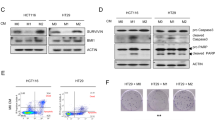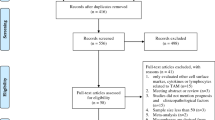Abstract
Recent research has indicated that separate populations of macrophages are associated with differing outcomes in cancer survival. In our study, we examine macrophage expression of tartrate-resistant acid phosphatase (TRAP) and its effect on survival in colon cancer. Immunohistochemical analysis on colorectal adenocarcinomas confirmed macrophage expression of TRAP. Co-localization of TRAP with CD68, a pan-macrophage marker, revealed that TRAP is present in some but not all sub-populations of macrophages. Further co-localization of TRAP with CD163, an M2 marker, revealed that TRAP is expressed by both M2 and non-M2 macrophages. TRAP expression was then measured using the AQUA method of quantitative immunofluorescence in a tissue microarray consisting of 233 colorectal cancer patients seen at Yale-New Haven Hospital. Survival analysis revealed that patients with high TRAP expression have a 22 % increase in 5-year survival (uncorrected log-rank p = 0.025) and a 47 % risk reduction in disease-specific death (p = 0.02). This finding was validated in a second cohort of older cases consisting of 505 colorectal cancer patients. Patients with high TRAP expression in the validation set had a 19 % increase in 5-year survival (log-rank p = 0.0041) and a 52 % risk reduction in death (p = 0.0019). These results provide evidence that macrophage expression of TRAP is associated with improved outcome and implicates TRAP as a potential biomarker in colon cancer.





Similar content being viewed by others
References
Algars A, Irjala H, Vaittinen S, Sundstrom J, Salmi M, Ristamaki R, Jalkanen S (2012) Type and location of tumor-infiltrating macrophages and lymphatic vessels predict survival of colorectal cancer patients. Int J Cancer 131:864–873
Ashkar S, Weber GF, Panoutsakopoulou V, Sanchirico ME, Jansson M, Zawaideh S, Rittling SR, Denhardt DT, Glimcher MJ, Cantor H (2000) Eta-1 (osteopontin): an early component of type-1 (cell-mediated) immunity. Science (New York, NY) 287:860–864
Camp RL, Chung GG, Rimm DL (2002) Automated subcellular localization and quantification of protein expression in tissue microarrays. Nat Med 8:1323–1327
Camp RL, Dolled-Filhart M, Rimm DL (2004) X-tile: a new bio-informatics tool for biomarker assessment and outcome-based cut-point optimization. Clin Cancer Res 10:7252–7259
Edin S, Wikberg ML, Dahlin AM, Rutegard J, Oberg A, Oldenborg PA, Palmqvist R (2012) The distribution of macrophages with a M1 or M2 phenotype in relation to prognosis and the molecular characteristics of colorectal cancer. PLoS One 10:e47045
Forssell J, Oberg A, Henriksson ML, Stenling R, Jung A, Palmqvist R (2007) High macrophage infiltration along the tumor front correlates with improved survival in colon cancer. Clin Cancer Res 13:1472–1479
Fujimoto J, Sakaguchi H, Aoki I, Tamaya T (2000) Clinical implications of expression of interleukin 8 related to angiogenesis in uterine cervical cancers. Cancer Res 60:2632–2635
Galon J, Costes A, Sanchez-Cabo F, Kirilovsky A, Mlecnik B, Lagorce-Pages C, Tosolini M, Camus M, Berger A, Wind P, Zinzindohoue F, Bruneval P, Cugnenc PH, Trajanoski Z, Fridman WH, Pages F (2006) Type, density, and location of immune cells within human colorectal tumors predict clinical outcome. Science (New York, NY) 313:1960–1964
Goede V, Brogelli L, Ziche M, Augustin HG (1999) Induction of inflammatory angiogenesis by monocyte chemoattractant protein-1. Int J Cancer Suppl 82:765–770
Hakansson L, Adell G, Boeryd B, Sjogren F, Sjodahl R (1997) Infiltration of mononuclear inflammatory cells into primary colorectal carcinomas: an immunohistological analysis. Br J Cancer 75:374–380
Hanada T, Nakagawa M, Emoto A, Nomura T, Nasu N, Nomura Y (2000) Prognostic value of tumor-associated macrophage count in human bladder cancer. Int J Urol 7:263–269
Hauptmann S, Zwadlo-Klarwasser G, Hartung P, Klosterhalfen B, Kirkpatrick CJ, Mittermayer C (1994) Association of different macrophage phenotypes with infiltrating and non-infiltrating areas of tumor-host interface in colorectal carcinoma. Pathol Res Pract 190:159–167
Hayman AR (2008) Tartrate-resistant acid phosphatase (TRAP) and the osteoclast/immune cell dichotomy. Autoimmunity 41:218–223
Heys SD, Stewart KN, McKenzie EJ, Miller ID, Wong SY, Sellar G, Rees AJ (2012) Characterisation of tumour-infiltrating macrophages: impact on response and survival in patients receiving primary chemotherapy for breast cancer. Breast Cancer Res Treat 135:539–548
Honig A, Rieger L, Kapp M, Krockenberger M, Eck M, Dietl J, Kammerer U (2006) Increased tartrate-resistant acid phosphatase (TRAP) expression in malignant breast, ovarian and melanoma tissue: an investigational study. BMC Cancer 6:199
Janckila AJ, Yam LT (2009) Biology and clinical significance of tartrate-resistant acid phosphatases: new perspectives on an old enzyme. Calcif Tissue Int 85:465–483
Komohara Y, Hirahara J, Horikawa T, Kawamura K, Kiyota E, Sakashita N, Araki N, Takeya M (2006) AM-3 K, an anti-macrophage antibody, recognizes CD163, a molecule associated with an anti-inflammatory macrophage phenotype. J Histochem Cytochem 54:763–771
Koukourakis MI, Giatromanolaki A, Kakolyris S, O’Byrne KJ, Apostolikas N, Skarlatos J, Gatter KC, Harris AL (1998) Different patterns of stromal and cancer cell thymidine phosphorylase reactivity in non-small-cell lung cancer: impact on tumour neoangiogenesis and survival. Br J Cancer 77:1696–1703
Lamp EC, Drexler HG (2000) Biology of tartrate-resistant acid phosphatase. Leuk Lymphoma 39:477–484
Mantovani A, Sica A, Sozzani S, Allavena P, Vecchi A, Locati M (2004) The chemokine system in diverse forms of macrophage activation and polarization. Trends Immunol 25:677–686
Mantovani A, Sica A, Locati M (2007) New vistas on macrophage differentiation and activation. Eur J Immunol 37:14–16
Medrek C, Ponten F, Jirstrom K, Leandersson K (2012) The presence of tumor associated macrophages in tumor stroma as a prognostic marker for breast cancer patients. BMC Cancer 12:306
Mlecnik B, Tosolini M, Kirilovsky A, Berger A, Bindea G, Meatchi T, Bruneval P, Trajanoski Z, Fridman WH, Pages F, Galon J (2011) Histopathologic-based prognostic factors of colorectal cancers are associated with the state of the local immune reaction. J Clin Oncol 29:610–618
Moeder CB, Giltnane JM, Moulis SP, Rimm DL (2009) Quantitative, fluorescence-based in situ assessment of protein expression. Methods in molecular biology (Clifton, NJ) 520:163–175
Movahedi K, Laoui D, Gysemans C, Baeten M, Stange G, Van den Bossche J, Mack M, Pipeleers D, In’t Veld P, De Baetselier P, Van Ginderachter JA (2010) Different tumor microenvironments contain functionally distinct subsets of macrophages derived from Ly6C(high) monocytes. Cancer Res 70:5728–5739
Nagorsen D, Voigt S, Berg E, Stein H, Thiel E, Loddenkemper C (2007) Tumor-infiltrating macrophages and dendritic cells in human colorectal cancer: relation to local regulatory T cells, systemic T-cell response against tumor-associated antigens and survival. J Transl Med 5:62
Oddie GW, Schenk G, Angel NZ, Walsh N, Guddat LW, de Jersey J, Cassady AI, Hamilton SE, Hume DA (2000) Structure, function, and regulation of tartrate-resistant acid phosphatase. Bone 27:575–584
Raisanen SR, Alatalo SL, Ylipahkala H, Halleen JM, Cassady AI, Hume DA, Vaananen HK (2005) Macrophages overexpressing tartrate-resistant acid phosphatase show altered profile of free radical production and enhanced capacity of bacterial killing. Biochem Biophys Res Commun 331:120–126
Rimm DL, Camp RL, Charette LA, Costa J, Olsen DA, Reiss M (2001a) Tissue microarray: a new technology for amplification of tissue resources. Cancer J (Sudbury, Mass) 7:24–31
Rimm DL, Camp RL, Charette LA, Olsen DA, Provost E (2001b) Amplification of tissue by construction of tissue microarrays. Exp Mol Pathol 70:255–264
Robinson BD, Sica GL, Liu YF, Rohan TE, Gertler FB, Condeelis JS, Jones JG (2009) Tumor microenvironment of metastasis in human breast carcinoma: a potential prognostic marker linked to hematogenous dissemination. Clin Cancer Res 15:2433–2441
Scott KL, Nogueira C, Heffernan TP, van Doorn R, Dhakal S, Hanna JA, Min C, Jaskelioff M, Xiao Y, Wu CJ, Cameron LA, Perry SR, Zeid R, Feinberg T, Kim M, Vande Woude G, Granter SR, Bosenberg M, Chu GC, DePinho RA, Rimm DL, Chin L (2011) Proinvasion metastasis drivers in early-stage melanoma are oncogenes. Cancer Cell 20:92–103
Steidl C, Lee T, Shah SP, Farinha P, Han G, Nayar T, Delaney A, Jones SJ, Iqbal J, Weisenburger DD, Bast MA, Rosenwald A, Muller-Hermelink HK, Rimsza LM, Campo E, Delabie J, Braziel RM, Cook JR, Tubbs RR, Jaffe ES, Lenz G, Connors JM, Staudt LM, Chan WC, Gascoyne RD (2010) Tumor-associated macrophages and survival in classic Hodgkin’s lymphoma. N Engl J Med 362:875–885
Talmadge JE, Donkor M, Scholar E (2007) Inflammatory cell infiltration of tumors: Jekyll or Hyde. Cancer Metastasis Rev 26:373–400
Acknowledgments
We would like to thank Lori Charette and her team in YPTS for construction of the tissue microarrays used in the work. This work is supported by departmental funds and a grant from the NIH (R01 CA 114277).
Author information
Authors and Affiliations
Corresponding author
Rights and permissions
About this article
Cite this article
How, J., Brown, J.R., Saylor, S. et al. Macrophage expression of tartrate-resistant acid phosphatase as a prognostic indicator in colon cancer. Histochem Cell Biol 142, 195–204 (2014). https://doi.org/10.1007/s00418-014-1181-6
Accepted:
Published:
Issue Date:
DOI: https://doi.org/10.1007/s00418-014-1181-6




